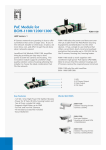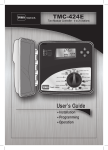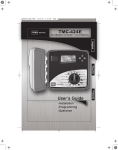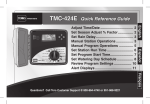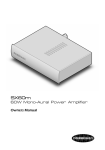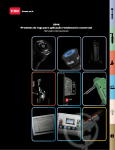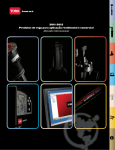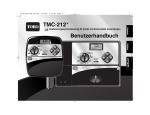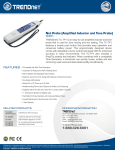Download Toro 2-Wire Installation Manual
Transcript
GDC 200 Stand-Alone Model Installation Instructions Specifications: • Controls up to 200 stations for the Stand-Alone model • Input power supply 100 VAC, 50/60Hz 120 VAC, 50/60Hz 240 VAC, 50/60Hz • GDC output voltage: 40 VAC max. • GDC output power: 98VA max. • Storage temperature: -30C–60C • Operating temperature: 0–60C • Cabinet Type: Non-corrosive, lockable wall mount, indoor/outdoor installation • Six 25.4mm conduit openings and one 38mm conduit opening Cabinet Installation Selecting the proper installation site for the GDC is essential to safe and reliable operation. The GDC features a weather resistant cabinet designed for indoor or outdoor installation. The GDC should be installed on a vertical wall or other sturdy structure near a grounded power source. Select a location that shades the controller during the hottest hours of the day and provides as much protection from direct sunlight, rain, wind and snow as possible. DO NOT mount the controller where it is exposed to direct spray from the irrigation system. For easy operation and better view of the display, install the GDC so that the display is at or slightly below eye level. Step 1 – Drill two pilot holes 15.25cm apart for the top keyholes of the controller cabinet. Step 2 – Install the top screws leaving approximately 5–6mm of exposed screw to accommodate the cabinet. If mounting the cabinet on dry wall or masonry, install the appropriate type of screw anchors or fasteners to ensure secure installation. 15.25cm 23.175cm Step 3 – Hang the cabinet using the top keyhole slots. See Figure 1. Step 4 – Open the cabinet door and install the bottom two screws to secure the cabinet. Figure 1 Earth Ground Installation IMPORTANT! The GDC surge protection components cannot properly function unless an efficient pathway to earth ground is provided. The ground path must be as direct as possible, without sharp bends and must not exceed 30 Ohm resistance (when measured with an earth ground resistance device). All electrical components throughout the irrigation system should be grounded similarly to provide the same ground potential. The following instructions depict one of several acceptable earth grounding methods. Due to variables in soil composition and terrain, the method shown may not be suitable for your installation site. Contact your local Toro distributor for assistance and availability of the required earth ground resistance test instrument. Step 1 – Drive a 5/8" x 8' (17mm x 2.5m) copper-clad steel rod into well moistened soil not less than 8' (2.5m) or not more than 12' (3.7m) from the controller cabinet. The top of the ground rod should be 12" (30.5cm) below grade level. See Figure 2. Step 2 – Using a 5/8" (17mm) clamp or “Cad weld” fastener, attach an 8 AWG (8mm2) solid copper wire near the top of the o ground rod. Avoiding wire bends of less than 8" (20.3cm) radius and more than 90 , route the wire through conduit and into the cabinet. Secure the wire to the copper ground lug. Make sure the soil surrounding the ground rod(s) remains well moistened at all times. The addition of some form of irrigation may be required if the cabinet is installed in a non-irrigated location. Step 3 – Measure the ground resistance per the instructions provided with the ground test instrument. A reading of 0.0 Ohm is optimum, up to 10 Ohm is good and 11–30 Ohm is acceptable in most cases. If the resistance exceeds the acceptable limit, additional ground rod(s) can be installed at a distance equal to twice the buried depth of the first rod; i.e., 16' (4.9m). Interconnect the ground rods using 8 AWG (8mm2) solid copper wire and test again. If the measured ground resistance continues to read above the acceptable limit, contact your local Toro distributor for further assistance and recommendations. Installing a round valve box over the ground rod enables the ground rod to be easily located as well as providing access to the ground wire connection(s). Figure 2 Ground Lug Valve Box 8 AWG (8mm2) Solid Copper Ground Wire 12" (30.5cm) 8" (20.3cm) Minimum Radius 8'–12' (2.4m – 3.7m) Ground Wire To Additional Rod(s) (Optional) Copper Clad Ground Rod 90o Minimum Angle Power Source Installation WARNING! AC POWER WIRING MUST BE INSTALLED AND CONNECTED BY QUALIFIED PERSONNEL ONLY. ALL ELECTRICAL COMPONENTS AND INSTALLATION PROCEDURES MUST COMPLY WITH ALL APPLICABLE LOCAL AND NATIONAL ELECTRICAL CODES. SOME CODES MAY REQUIRE A MEANS OF DISCONNECTION FROM THE AC POWER SOURCE, INSTALLED IN THE FIXED WIRING, HAVING A CONTACT SEPARATION OF AT LEAST 3mm IN THE LINE AND NEUTRAL POLES. ENSURE THE AC POWER SOURCE IS OFF PRIOR TO SERVICING. FAILURE TO COMPLY MAY RESULT IN SERIOUS INJURY DUE TO ELECTRICAL SHOCK HAZARD. Step 1 – Turn off the power at the power source location and place the controller’s power switch to OFF. Connect and route the appropriate size 3-conductor cable (10 AWG [2.5mm2] maximum) from the power source to the controller cabinet. Figure 3 The provided power cable access hole can accommodate a 1" (25mm) conduit fitting. If conduit is required, install a section of flexible 1" (25mm) electrical conduit from the power source conduit box to the cabinet’s access hole. Step 2 – Open the cabinet door and remove the two retaining screws from the power supply cover. Step 3 – Locate the voltage cable assembly and note the voltage on the label. The GDC is equipped with 120V cable assembly from the factory. Replace the voltage cable assembly with the proper rating as necessary. See Figure 3. Voltage Cable Assembly Step 4 – Strip the power cables and secure them to the terminal block. Reference Table 1 for the appropriate type of power connection. Step 5 – Reinstall the power supply cover. Step 6 – Apply power to the controller. Flexible Conduit (Optional) Equipment Ground Line Neutral Station Decoder Installation The station decoder module is available in 1-station, 2-station or 4-station configuration. The decoder modules are installed into the GDC output board terminals. The GDC model can handle up to 100 stations per output board. These stations can be connected to the output board terminals in any configuration (25 stations connected to each of the four terminal pairs or 100 stations connected to one terminal pair, etc.). The decoder modules can be connected in parallel anywhere on the two-wire communication line connected to the station terminals. Each station can activate up to two solenoids. It is recommended that the decoder modules are installed in an approved valve box to provide easy access to the wiring. Use high-voltage waterproofing to all the wire connections. Recommended Controller-to-Decoder cable: 14 AWG (2.5mm2), solid copper, jacketed 2-conductor, direct burial. The preferred wire make and model is the Paige Irrigation Wire, Spec P7350D. Recommended Decoder-to-Solenoid cable: 14 AWG (2.5mm2), solid copper, 2-conductor, direct burial. The preferred wire make and model is the Paige Irrigation Wire, Spec P7351D. IMPORTANT! Cable Splices: In order for the wire connections to comply with the 2005 edition of the National Electric Code® Article 300.5 (Underground Installations) and 110.14 (Electrical Connections), in wet or damp locations, the connector must be listed under specification “UL 486D” if installed in a valve box. It must be listed under specification “UL 486DDirect Burial” if buried in dirt. This requirement applies to all electrical connections in wet or damp locations, regardless of voltage. The 3M DBY-6 and DBR-6 are listed as “UL 486D-Direct Burial” and meet these requirements for all underground installations. Cable Burial Depth: The GDC decoder operate at voltages between 30–40 volts. The 2005 edition of the National Electrical Code®, Article 300-5, requires that wires and cables subjected to voltages higher than 30 volts are to have a minimum cover of 24" (60.96 cm). • Use only wire approved for direct burial if installing the wires underground without conduit. • All field wiring splices must be accessible to facilitate troubleshooting and/or service. Step 1 – Route communication cable from the controller to the station decoder module installation location. The maximum wire length between the controller and the decoder module is 15,000' (4500m). Step 2 – Secure the communication wires to terminal 1 of the GDC output board. White wire onto the 1st terminal and black wire onto the second terminal. See Figure 4. Step 3 – Install the decoder module in a valve box. Record the decoder module’s address number found on the side label. This address number identifies the station(s) that the decoder module control. Step 4 – Secure the communication wires to the decoder module’s black and white wires. Connect the black communication wire to the black decoder module wire. Connect the remaining communication wire (white) to the white decoder module wire. Use proper water proofing method for all wire connections. Step 5 – Route output wires from the decoder module to the solenoid. The maximum wire length between the decoder module and the solenoid is 410' (125m). Step 6 – Connect the solenoid wires to the decoder module’s station wires. The station wires are color coded for easy identification. Connect the solid colored (red, green, orange or blue) station wire to the red/white solenoid wire. Connect the similar color station wire with black stripe to the black solenoid wire. Waterproof all wire connections. Step 7 – Connect an additional solenoid to the station wire as necessary. Each station has a maximum load of two solenoids for pressure up to 150 PSI or 10 bar. One solenoid per station loading for pressure exceeding 150 PSI or 10 bar. Step 8 – Repeat Steps 3–8 for additional decoder modules. Figure 4 DC Latching Solenoid Red Black White Power/Communication Wire Black Power/Communication Wire Station 1 Solid Red Station Wire - Connect to the Red/White solenoid wire Red with Black Stripe Station Wire - Connect to the Black solenoid wire Station 2 Solid Green Station Wire - Connect to the Red/White solenoid wire Green with Black Stripe Station Wire - Connect to the Black solenoid wire Station 3 Solid Orange Station Wire - Connect to the Red/White solenoid wire Orange with Black Stripe Station Wire - Connect to the Black solenoid wire Station 4 Solid Blue Station Wire - Connect to the Red/White solenoid wire Blue with Black Stripe Station Wire - Connect to the Black solenoid wire Each station can activate up to two DC Latching Solenoids. 1-Station Decoder Module Output Board Station Wires White Black White Black White Black White Black Out to additional decoder modules The GDC output board can accommodate up to 100 stations. The decoder modules can be connected in any configuration using the four station terminals. Paths – 1 2 3 4 The maximum communication wire length between the decoder module and the solenoid is 410ft (125m). Recommended Cable for Decoder-to-Solenoid is the Paige® P7351D, 14 AWG, Solid Copper, 2-Conductor, Direct Burial cable. Valve Box To easily identify stations for troubleshooting, install wires with the same color code as the station wires. When possible, install the decoder module in a valve box for ease of service. Maximum communication wire length between the controller and the farthest decoder is 15,000ft (4500m). Recommended Cable for Controller-to-Decoder is the Paige® P7350D, 14 AWG, Solid Copper, Jacketed 2-Conductor, Direct Burial cable. Grounding Communication Cable IMPORTANT! Cable Splices: In order for the wire connections to comply with the 2005 edition of the National Electric Code® Article 300.5 (Underground Installations) and 110.14 (Electrical Connections), in wet or damp locations, the connector must be listed under specification “UL 486D” if installed in a valve box. It must be listed under specification “UL 486D-Direct Burial” if buried in dirt. This requirement applies to all electrical connections in wet or damp locations, regardless of voltage. The 3M DBY-6 and DBR-6 are listed as “UL 486D-Direct Burial” and meet these requirements for all underground installations. Cable Burial Depth: The GDC decoder operate at voltages between 30–40 volts. The 2005 edition of the National Electrical Code®, Article 300-5, requires that wires and cables subjected to voltages higher than 30 volts are to have a minimum cover of 24" (60.96 cm). The optional lightning arrester (Toro P/N DEC-SG-LINE) is available to protect the decoder module in lightning prone areas. Without lightning arrester, the decoder are vulnerable to lightning damage. In order for these arrester to discharge lightning energy efficiently, they must be properly grounded. Figure 5 illustrates the proper grounding and wiring of the arrester. Step 1 – Locate decoder’s power/communication wires (black and white wires). Disconnect the wire connectors that joins it to the controller-to-decoder cable. Step 2 – Strip the insulation from lightning arrester’s white wire and connect it to the white wires from the decoder and controller-to-decoder cable. Secure the splices with a water proofed wire connector. (See Figure 5.) Step 3 – Strip the insulation from lightning arrester’s black wire and connect it to the black wires from the decoder and controller-to-decoder cable. Secure the splices with a water proofed wire connector. (See Figure 5.) Step 4 – Connect the lightning arrester’s ground wire to the ground plate’s wire. If the ground plate is not pre-wired, use a 10 AWG bare copper wire. (See Figure 5.) IMPORTANT! Verify that the wire length between the lightning arrester and the ground plate is no less than 3' (91.44 cm). Longer lengths will decrease the lightning arrester’s effectiveness. Step 5 – Bury the Ground plate next to the valve box or decoder’s location. Set it at the maximum depth that the ground wire would allow. Surround the ground plate with 50 lbs (2.68 Kg) of Earth contact material such as PowerSet® (Paige Electric, part number 1820058). Step 6 – Check the system for proper operation. Figure 5 Toro Decoder Module Use Paige P7351D for Decoder-to-Solenoid Communication Wiring Lightning Arrester Toro P/N DEC-SG-LINE Paige P7350D Controller-to-Decoder Communication Cable 4'' x 36'' (10.16 cm x 91.44 cm) Ground Plate - Surrounded by 50 lbs (2.68 Kg) of PowerSet® 3' (91.4 cm) Minimum Distance Between the Arrester and the Ground Plate Figure 6 Pressure Sensor Terminals Rain Sensor Terminals Toro Maintenance Remote (TMR) Receiver Plug Master Valve / Pump Relay Switch Terminals The 28VAC (Label A) can also be used to power the Toro Wireless Rain Sensor (TWRS/TWRFS) receiver. A A 24-Volts Transformer (Voltage Source must not exceed 3 Amps Max, 28 Volts Max) Master valve or Pump Relay Pressure Sensor Rain Sensor Master Valve / Pump Relay Installation GDC provide switch terminals to control a master valve or a pump relay if the system requires it. Step 1 – Place the controller’s power switch to OFF. Step 2 – Connect the Positive/Hot wire of the power source that controls the master valve or the pump relay to the Master valve/Pump relay switch terminal. See Figure 6. Step 3 – Route another wire from the Master Valve / Pump terminal and connect it to the master valve solenoid or pump relay. Step 4 – Connect the Negative/Equipment ground wire of the power source to the master valve solenoid or pump relay. Step 5 – Place the controller’s switch to ON. Pressure Sensor Installation The GDC 200 controller is designed to accept a normally-closed pressure sensor. Step 1 – Place the controller’s power switch to OFF. Step 2 – Route the pressure sensor’s cable into the controller. Step 3 – Connect the cable wires to the Pressure Sensor Terminals (See Figure 6). Step 4 – Place the controller’s switch to ON. Rain Sensor Installation The GDC 200 controller is designed to accept a normally-open rain switch. Step 1 – Place the controller’s power switch to OFF. Step 2 – Route the rain sensor’s cable into the controller. Step 3 – Connect the cable wires to the Rain Sensor Terminals (See Figure 6). Step 4 – Place the controller’s switch to ON. Toro Maintenance Remote (TMR) Receiver Plug Installation The GDC 200 controller is fully ccompatible with the TMR remote. See TMR’s User’s Guide for operating and mounting instructions. Step 1 – Place the controller’s power switch to OFF. Step 2 – Route the TMR’s receiver plug cable into the controller. Step 3 – Connect the RJ45 plug into the socket shown in Figure 6. Step 4 – Connect the power wires into the 28 VAC terminals labeled A in Figure 6. Step 5 – Place the controller’s switch to ON. Lithium Battery Replacement A 3.9V Lithium battery (P/N 363-2200) is installed in the timing mechanism to sustain the controller’s clock time and date for approximately 10-years with no additional power applied. WARNING! DANGER OF EXPLOSION IF BATTERY IS INSTALLED INCORRECTLY. REPLACE ONLY WITH THE SAME OR EQUIVALENT TYPE OF BATTERY. ALWAYS DISPOSE OF USED BATTERIES ACCORDING TO THE MANUFACTURER’S INSTRUCTIONS. Step 1 – Place the controller’s power switch to OFF. Step 2 – Remove the ribbon cable from the rear of the timing mechanism. Step 3 – Remove timing mechanism’s circuit board by pushing the retaining clip downward while carefully pulling the PCB board. See Figure 6. Step 4 – Secure the Lithium battery into the battery socket. See Figure 7. Step 5 – Reattach the circuit board to the timing mechanism. Step 6 – Secure the ribbon cable back to the timing mechanism socket. Step 8 – Place the controller’s switch to ON. Figure 6 Figure 7 Push Retaining Clip to Release the PCB Disconnect the Ribbon Cable Electromagnetic Compatibility Domestic: This equipment has been tested and found to comply with the limits for a FCC Class A digital device, pursuant to part 15 of the FCC Rules. These limits are designed to provide reasonable protection against harmful interference when the equipment is operated in a commercial environment. The equipment generates, uses, and can radiate radio frequency energy and, if not installed and used in accordance with the instruction manual, may cause harmful interference to the radio communications. Operation in a residential area is likely to cause harmful interference in which case the user will be required to correct the interference at his own expense. International: This is a CISPR 22 Class A product. In a domestic environment, this product may cause radio interference, in which case the user may be required to take adequate measures.Each stations can activate up to two solenoids. © 2009 The Toro Company, Irrigation Division • An ISO-9000-Certified Facility Form Number 373-0446 Rev. B








